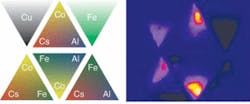While silicon and other photovoltaic solar cells get much press and are widely used, another lesser-known approach to solar-cell technology holds great promise, in particular because it can potentially eliminate the need for storage batteries and other awkward ways of compensating for sunlight’s variability. This approach—production of hydrogen from water by direct photoelectrolysis—is still in its early technical stages: the most-practical photocatalytic semiconducting material has not even been identified yet, at least in part because of the needed to test each slight variation in material chemistry. But researchers at Colorado State University (CSU; Fort Collins, CO) have greatly sped up the experimental process with the aid of a technology familiar to everyone—the inkjet printer.1
To be practical, a solar-photoelectrolytic material must not only split water efficiently, but should have a bandgap that is not so large that it prevents most of the solar spectrum from being absorbed; the material should also operate stably for many years in harsh sunlight. The CSU group believes that a nanostructured oxide semiconductor will be the ultimate practical material; it will be deposited on the backside of a glass substrate—allowing for back illumination, which reduces scattering of sunlight. The material, they also believe, will contain multiple metals that, when added together, will create stability, high absorption, and efficient catalysis.
Printed experiments
Although optimizing the multiple-metal chemistry could ordinarily bog down experimenters for years, the CSU scientists treat each individual metal as if it were ink of a separate color; they print the various materials onto glass in patterns of continuously varying “hues,” allowing testing of a whole set of metal combinations at once. The metal oxide precursors the team started with included nitrates of aluminum (Al), iron (Fe), cesium (Ce), and cobalt (Co); in addition, copper nitrate was included as an experimental reference. The materials were printed in a “four metals, three at a time” pattern onto fluorine-doped tin oxide coated glass, and then fired, resulting in oxides (see figure).
Under green laser light and in a solution containing sodium hydroxide (NaOH), two regions within the triangles showed a strong photocurrent response (more than twice as strong as the copper oxide internal reference): these were the Co-rich areas within the Co-Al-Fe and Co-Al-Cs triangles. But the mere consumer-level quality of the inkjet printer produced only qualitatively understood patterns, preventing the researchers from knowing the precise proportions of metals in the high-performing regions.
To learn more, they turned to a research-grade inkjet printer made by Fujifilm Dimatix (Santa Clara, CA). Not only were the volumes of the printed drops from this printer precisely known, but the printer itself contained two small CCD cameras (with LED light sources), one camera to watch droplets coming out of the printhead and the other to monitor images of printed droplets after deposition on the substrate; the cameras’ fields of view were each approximately 1.2 × 1.6 mm.
Concentrating on the Co-Fe-Al combination, the researchers printed a large rectangular array of squares, each square with a different ratio of Co to Fe to Al. In a NaOH solution and under the green light, the multimetal combination best-suited for photoelectrolysis then showed up right away: it consisted of 10% Fe, 84% Co, and 6% Al. A subsequent inkjet-printed array of four squares of this one material, all with varying film thicknesses, allowed the researchers to find the best thickness, which was about 60 nm.
Future development, more related to manufacture of a practical photoelectrolytic cell, will result in a thicker nanocrystalline film that is opaque and has a very high surface area, both qualities needed to boost efficiency. The result could one day be the convenient storage of solar energy in tanks, and even its sale and dispensing at “gas” stations.
REFERENCE
1. M. Woodhouse and B.A. Parkinson, Chemistry of Materials 20, 2495 (March 8, 2008).

